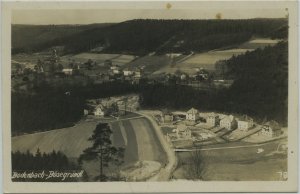
Scrapers (Škrabky)

| Popis |
Until 1945, the village Žlíbek, colloquially also Scrapers (formerly Škráble or Škrabotiny), was named Bösegründel. The current official name of Žlíbek was obtained by the Ministry of the Interior's decree of 28 June 1946. There was originally only one farm on the place of the village (probably later No. 7). The village of Žlíbek was founded in the period around 1545 by the parcel of this estate, on whose grounds the first houses were planted. The name of the village gave the surname of the former owner of the estate "Böse" in conjunction with the word "Gründel" (Žlíbek, ie a small valley). The village fell under the rule of the village of Weiher, which stretched from Labský Embankment along today's Teplická Street and later merged with neighboring Podmokly. In 1581, Žlíbek had five small agricultural (horticultural) farmhouses, their number increased to six in the 17th century. The mining gneiss here in 1654 lists four horticultural and two domestic houses, together six houses. The Theresian cadastre (1713) recorded seven houses and Schaller's topography (1787) for nine. In 1833 there were 54 residents in ten houses. Even after the merger with the Podmokly in 1850, the settlement remained aside from interest, and in 1910 there were only thirteen houses there. After the First World War, the first villas began to grow in the former meadows and fields around the village of Žlíbek, so by 1930 the number of houses had doubled to 26 and increased to 39 by the second world war. century, when the existing buildings were thickened with new family houses and all the former fields and meadows were built so that the village now forms a coherent whole with the neighboring Červený Vrch. In 1927 an interconfessional cemetery was established on the outskirts of the village for the then independent town of Podmokly, which gradually replaced the old and capacity-filled cemetery around the church in Rozběles. The entrance to the new cemetery is decorated with a ceremonial hall with a small bell tower. To date, a number of architecturally interesting tombs have been preserved in the cemetery and a unique set of stellar sandstone tombstones from the turn of the 1930s and 1940s has been preserved in its upper part. |





